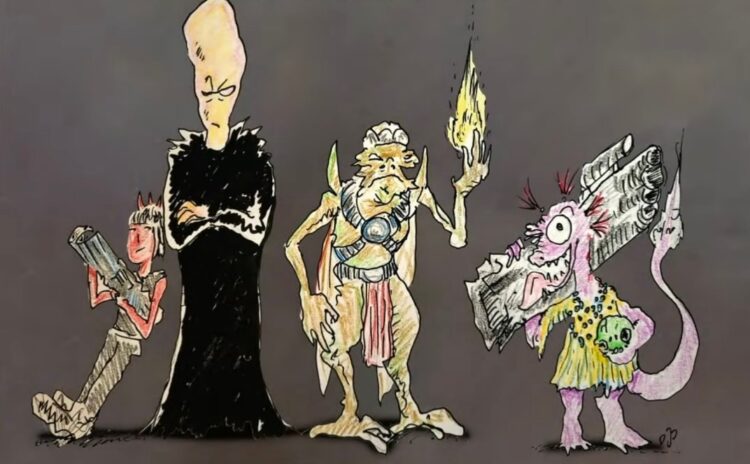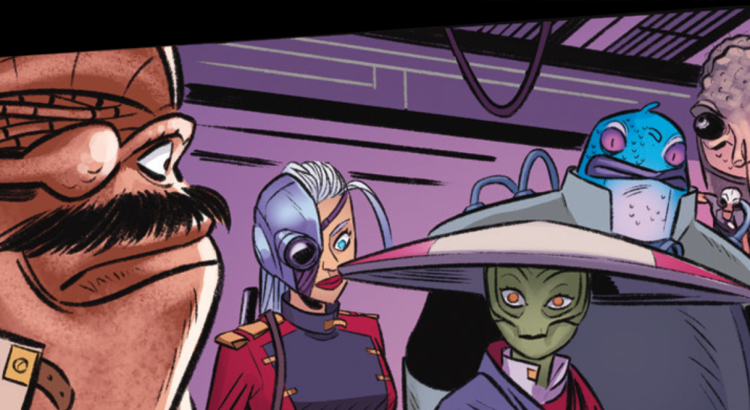I’m going to confess something: comedy is not my thing. I don’t dislike comedy; I don’t dislike laughing. I don’t think everything should be grim, dark, and edgy. But I have a hard time understanding comedy, on a technical level. I have a hard time picking it apart, peering inside to see how it functions. I’ve tried. I’ve read books and articles on how to write comedy, but it’s still this black box in storytelling that eludes me. Maybe it’s the autism.
I think this is why I took so much longer to put words to issue #2 of The High Republic Adventures than issue #1. Because everyone already said it. From the early reviews to the general reader response: it’s a laugh riot. I myself howled, out loud, a multitude of times. It’s hilarious. What more is there to say?
Comedy is not my thing.
But I also know that comedy itself is a form of storytelling. It requires pacing, setup, payoff, emotional buy-in. It’s why it’s so common for good comedic actors to also be good at drama. It’s why Jordan Peele, who made his name in sketch comedy, delivers quality horror again and again.
So I didn’t want to just dismiss this issue from analysis because it was funny. As much as I struggle with understanding the way comedy functions, issue #2 is still art. It’s still craft. There’s still an entire creative team that put effort into making this a cohesive story, that moves the story forward and reveals elements of our characters. There is still a function…
…a narrative function. Now that is something I do understand. I can’t break apart a joke and tell you how it works. But maybe I can tell you where the jokes fit with the other story elements. And I see three narrative functions that comedy plays in The High Republic Adventures issue #2.
1) Perspective
The characters face great danger in this issue. Ships get stolen, fired upon, and flown on crash courses with each other. Many characters express the fear of dying and their helplessness to stop it. Throughout this chaos, we cut away to the Dank Graks, to Maz and Dex on the ship’s bridge, to Raf in his own fighter. But the primary lens through which we experience all this mayhem is still Sav Malagán. A teenage girl absolutely stoked to be here.

As the protagonist, her glee infects every panel of the comic. We see it all, even the danger, as Sav herself sees it. We aren’t just told that she’s delighted; we’re invited to join her in that delight.
Contrast this with another Sav Malagán story: Edge of Balance Volume 2. Set years later, in Sav’s time as a Jedi Master, the protagonist is Jedi Knight Lily Tora-Asi. While there’s no shortage of humor, the more serious tone of the manga tracks with Lily and Lily’s assessment of the threat at hand.
Even issue #1 of The High Republic Adventures, while light in tone, is not nearly the same rambunctious comedy that is issue #2. There, Padawan Sav does consider for a moment that she might very well die against the Dank Graks’ droids. More gravity – in both writing and art – is given to the threat, is given to the atmosphere, is given to the pirates.
Which brings us to the second narrative function of comedy.
2) Vulnerability
In Every Frame A Painting’s episode on Jackie Chan, video essayist Tony breaks down how Chan makes not just action comedy films, but how the action scenes themselves are comedic.
First off, he gives himself a disadvantage. No matter what film, Jackie always starts beneath his opponents. He has no shoes. He’s handcuffed. He has a bomb in his mouth. From this point, he has to fight his way back to the top.
(…) Unlike a lot of action stars who try to look invincible, Jackie gets hurt. A lot. Half the fun of his work is not only are the stunts impressive, there’s always room for a joke. Pain humanizes him. Because no matter how skilled he is, he still gets smacked in the face.
While physical pain isn’t an element of The High Republic Adventures’ humor [1]At least not in issue #2. Let us not forget Raf getting beaned with a tankard., the principle remains the same. The laughs come from vulnerability. From the cracks in the legendary expectations Sav has of her heroes. From peeling back the veil from them to reveal relatability.
Alak – a towering man with a scowl – isn’t surly because he’s a planning his next criminal scheme or being a stoic badass. Nor was the brawl in the last episode with Raf the pirate hunter some sort of ideological crusade. It was a lover’s spat. And now Alak is overthinking his last argument with his boyfriend.
Coromont Vizzle – a pirate with multiple ballads dedicated to his name – has a pair of reveals, the first of which is that he wrote the ballads. All of them. And the lyric declaring that “the law is always on his back” takes a very literal turn.

Dexter Jettster, despite appearing in fewer panels than Coromont and Alak, is still another demonstration of how humor humanizes these legends. Issue #1 – in both writing and art – displayed him as a self-assured badass. His eyes go pure white in determination. He snarls in the face of blaster fire. And now, in issue #2, he panics at the controls of this old, weird ship.
Each of these reveals – each delivered in a comedic moment – is accompanied by a reaction from Sav. Her expressions and words reveal she’s peeking through the cracks in her own hero worship to see these pirates as they are. She blanches in realizing her prank in issue #1 caused a rift in Alak’s personal relationship. She squints and frowns as Coromont blasély reveals his secrets. She meets Dex’s panicked expression with the flattest teenager look she can offer.
The humor of issue #2 is Sav – and us as the readers – realizing that these pirates, whom we regarded with such awe in issue #1, are just…people. People who can fail. People who can get hurt.
Which brings us to the third narrative function.
3) Threat
Twice now, Maz Kanata has warned us.
“The Dank Graks are a criminal outfit made up of rejects from various backwater Force factions around the galaxy. Bunch of losers, basically. But they’re ruthless and very connected.”
Issue #1
“The Dank Graks are eccentric, but don’t be fooled: they’re vicious and will do whatever it takes to get what they want.”
Issue #2
There is humor in the absurdity of the Dank Graks. They were introduced to us like this for goodness’ sake:

When we laugh at something, there is the instinct to not take it seriously. Which might very well put us in danger. Maz herself admits to falling into this in issue #2. She had expected this encounter with the Dank Graks to be a “quick little jaunt”, a fun adventure on which she could let the sneaky Padawan tag along. Maz had expected the humorous adventure that we saw from Sav’s perspective and instead was faced with the very real possibility that her crew and this tagalong kid might die.
I wonder if the comedy of issue #2 is playing that same game with us as readers.
When a reader approaches a work of writing, they come at it like a boxer with their gloves up. In theory, readers know what the point of a story is. It’s to make them feel things. But they need to be prepared to feel things. You can throw all the jabs and crosses and hooks you want at the reader with all of your emotional, tear-jerking scenes or terrifying twists and turns, but if they’re still guarding themselves, those punches won’t land.
You have to get readers to lower their guard. The easiest and most effective way to do that? Get them to laugh.
What better time to deliver on an emotional gut punch that will resonate like never before? Clearly after getting your reader to laugh, to let their guard down, to feel safe.
– “Why humor in fiction is so essential” by Josh Sippie, The Writer
Get us laughing at the absurdity, lose ourselves in the delightful comedy of this adventure, unaware of the stakes looming over our shoulder. I have my doubts that anyone will die in this all-ages comic, but the previous run of The High Republic Adventures hardly shied away from its own gut punches. Perhaps issue #2 is setting us – and Sav herself – up for such a blow.
Or perhaps I am reading too much into a literary technique that I do not understand. Comedy, after all, is not my thing.
| ↑1 | At least not in issue #2. Let us not forget Raf getting beaned with a tankard. |
|---|

